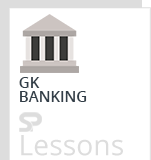 Introduction
Introduction
What is meant by Financial Awareness? Financial awareness foundation is financial literacy, which is defined as The ability to use knowledge and skills to effectively manage financial resources efficiently at a personal level and through the life cycle.
Financial Awareness is a section that is present in most of the banking competitive exams. Candidates planning to take up employment in the banking sector must be aware of many of the terms policies and other such important information related with financial awareness. The article Financial Awareness Quiz 19 provides quiz sets useful to the candidates while preparing Various Banking & Government Exams like IBPS RRB, SBI PO, SBI Clerk, SSC CPO, SSC CHSL.
 Quiz
Quiz
1. An emerging market economy is highly classified with relatively- one in which the country is becoming a developed nation and is determined through many socio ------
-
A. Economic factors
B. External factors
C. Commercial factors
D. GDP factors
E. Growth factors
-
A. Rs 1.5 lakh crore
B. Rs 2.5 lakh crore
C. Rs 3.5 lakh crore
D. Rs 4.5 lakh crore
E. Rs 5.5 lakh crore
-
A. BOP
B. GDP
C. CDS
D. GNP
E. NPA
-
A. Krushak Accommodation for Livelihood and Income Agriculture
B. Krushak Assistance for Livelihood and Income Augmentation
C. Krushak Accommodation for Livelihood and Independent Agriculture
D. Krushak Assistance for Livelihood and Independent Augmentation
E. None of the given options is true
-
A. 48%
B. 42%
C. 26%
D. 32%
E. 56%
1. In India, an Asset Reconstruction Company is regulated by?
-
A. MUDRA
B. SEBI
C. NABARD
D. EXIM
E. RBI
-
A. M1
B. M2
C. M3
D. M4
E. M5
-
A. Bank Board Bureau
B. Bank Beneficiary Bureau
C. Bank Bureau Board
D. Bank Bureau Beneficiary
E. None of the above
-
A. National Spot Exchange Limited (NSEL)
B. Indian Commodity Exchange Limited (ICEX)
C. National Commodity & Derivatives Exchange Limited (NCDEX)
D. Multi-Commodity Exchange of India Ltd (MCX)
E. Securities and Exchange Board of India (SEBI)
-
A. 2-7 days
B. 2-14 days
C. 2-21 days
D. 2-28 days
E. 2-90 days
1. Depositor Education and Awareness Fund (DEAF) is maintained by which of the following organisation?
-
A. NABARD
B. RBI
C. Public Provident Fund Authorities
D. SIDBI
E. IRDA
-
A. Government of India
B. Corporate
C. Primary dealers (PDs)
D. Only A and B is correct
E. Only B and C is correct
-
A. Headline Inflation
B. Core Inflation
C. Consumer Inflation
D. Real Inflation
E. Nominal Inflation
-
A. Agriculture
B. Education
C. Renewable Energy
D. Housing Loans
E. Export Import Credit
-
(i) Agriculture
(ii) Micro, Small and Medium Enterprises
(iii) Export Credit
(iv) Education
(v) Housing
(vi) Social Infrastructure
(vii) Renewable Energy
(viii) Others
-
A. Tools and Equipment
B. Amounts receivable
C. Capital Stock
D. Cash
E. All of these



